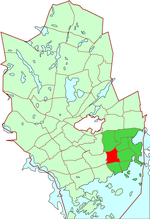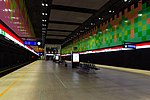Urheilupuisto metro station

Urheilupuisto (Finnish) or Idrottsparken (Swedish) (lit. English "Sports park") is an underground metro station in Espoo on the Länsimetro (‘Western Metro’) extension of Helsinki metro. The station is located in western Tapiola, at the northern edge of Jousenpuisto Park and south of the Tapiolan Urheilupuisto (Swedish: Hagalunds idrottspark; ‘Tapiola Sports Park‘). A 790-space car park was built next to the metro station and offers elevator access to the station. The station was designed by HKP Architects, in collaboration with many other design firms. During the design stage, the station was known as Jousenpuisto, after the park at its immediate south. The shape of the station building allows natural light to enter at street level and reach down to the platform level via the escalators. The metro station has won several international design awards as part of the eight-station first phase of the Länsimetro. Urheilupuisto is unique among metro stations in Espoo, as it is not built into the bedrock. The station platform is located at a depth of about 27 meters below street level. Urheilupuisto station was designed to operate with only one entrance (on the western side of the building) but, in response to passenger feedback, an entrance was constructed in the eastern side and opened on 29 February 2020. The station is located 1,1 kilometres east from Niittykumpu metro station and 1,3 kilometres west from Tapiola metro station.
Excerpt from the Wikipedia article Urheilupuisto metro station (License: CC BY-SA 3.0, Authors, Images).Urheilupuisto metro station
Jousenpuistonaukio, Espoo Tapiola (Suur-Tapiola)
Geographical coordinates (GPS) Address Nearby Places Show on map
Geographical coordinates (GPS)
| Latitude | Longitude |
|---|---|
| N 60.1748 ° | E 24.7803 ° |
Address
Jousenpuistonaukio
Jousenpuistonaukio
Espoo, Tapiola (Suur-Tapiola)
Finland
Open on Google Maps









